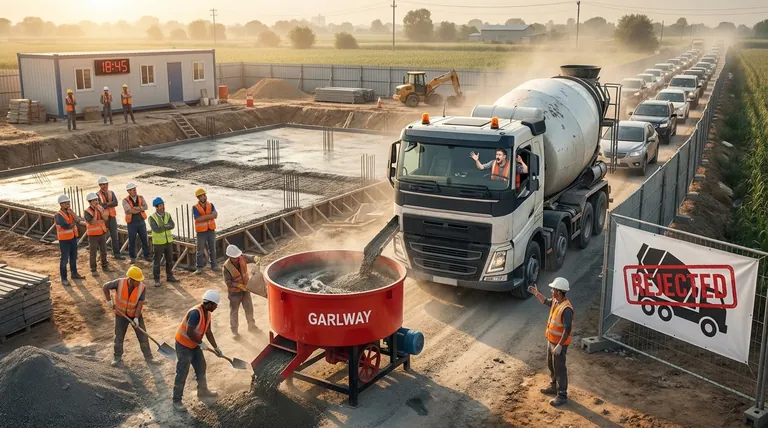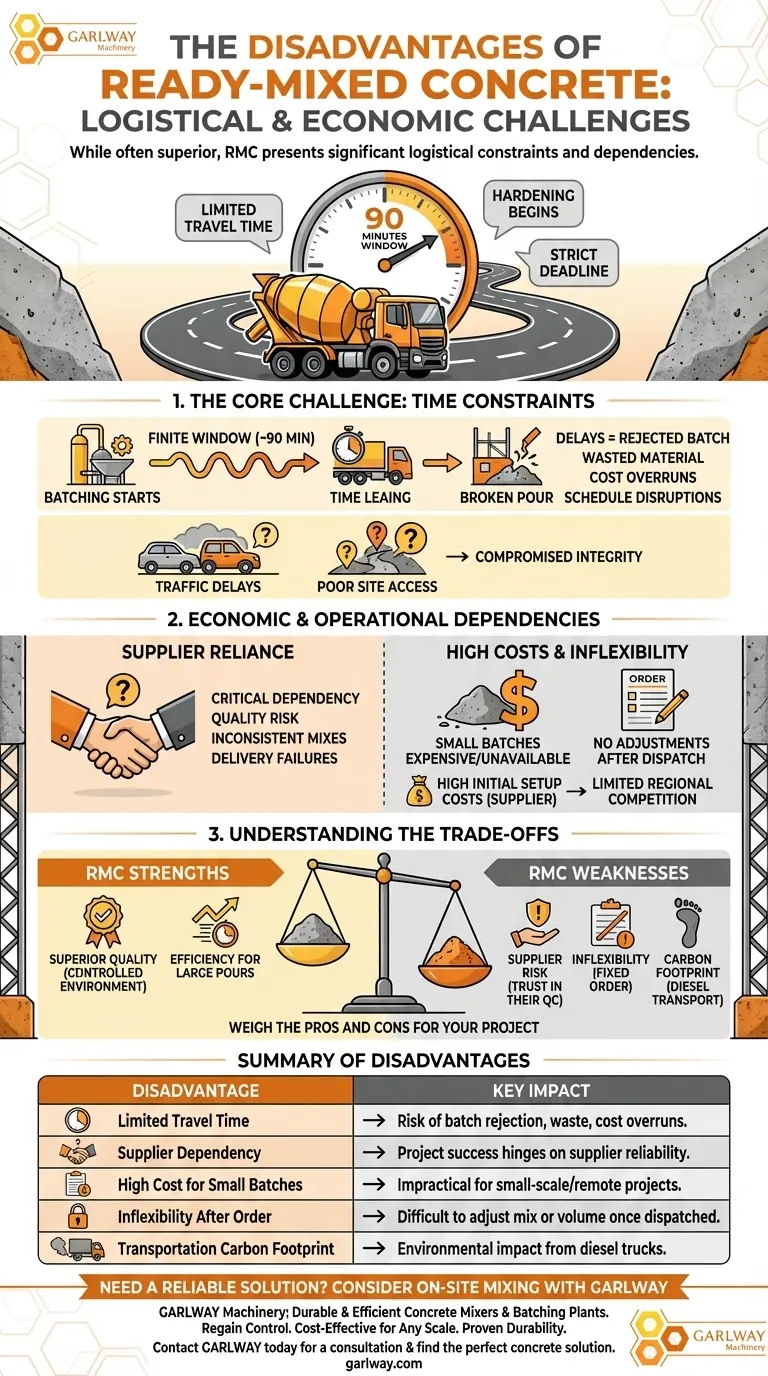While often the superior choice for modern construction, ready-mixed concrete is not without significant drawbacks. Its primary disadvantages stem from logistical constraints, particularly a limited travel time from the plant to the job site. This introduces risks related to scheduling, supplier dependency, and the high initial costs required to establish a batching plant, which can affect pricing and availability.
The disadvantages of ready-mixed concrete are not inherent flaws in the material itself, but rather logistical and economic challenges. They revolve around time constraints, supplier reliability, and the scale of the operation required to make it a viable choice.

The Core Logistical Challenge: Time
The fundamental challenge with ready-mixed concrete (RMC) is that the hydration process, where the concrete begins to harden, starts the moment water is added at the plant. This creates a non-negotiable window for transport, placement, and finishing.
### Limited Travel and Placement Window
Once batched, a truck of concrete has a finite amount of time, typically around 90 minutes, before it starts to lose workability and its quality degrades. This creates a strict deadline for the entire delivery and placement process.
Any delay in this window, whether from the supplier or on-site, can result in the entire batch being rejected. This leads to wasted material, significant cost overruns, and project schedule disruptions.
### The Impact of Traffic and Site Access
The journey from the plant to the site is a critical point of failure. Unforeseen traffic, road closures, or poor site access can easily cause delays that compromise the concrete's integrity.
Projects in remote or heavily congested urban areas must carefully account for this travel time risk, as it directly impacts the feasibility of using RMC.
Economic and Operational Dependencies
Choosing RMC means outsourcing a critical production step. This shifts risk and control from your team to an external supplier, introducing several economic and operational considerations.
### High Initial Setup Costs
While this cost is borne by the RMC producer, it is a significant barrier to entry that limits the number of available suppliers in a region.
This lack of competition can affect pricing, and the high capital investment is ultimately reflected in the cost passed on to the customer.
### Critical Reliance on the Supplier
Your project's timeline and quality become directly linked to the supplier's performance. A reliable supplier with certified quality control is a major asset.
However, a poor supplier can cause catastrophic problems, from delivering inconsistent mixes to failing to meet delivery schedules. Vetting your supplier is not just a recommendation; it is a critical risk mitigation step.
### Challenges with Small Batches
Ready-mix operations are built on volume and efficiency. Ordering small quantities of concrete is often disproportionately expensive or may not be offered at all.
For small repairs, remote work, or projects requiring minimal concrete, the logistics and cost of RMC are often prohibitive, making on-site mixing the more practical solution.
Understanding the Trade-offs
The disadvantages of RMC are best understood as trade-offs against the significant problems it solves, such as the inaccuracies and labor intensity of manual mixing.
### Quality Control vs. Supplier Risk
RMC offers superior quality and consistency because it is produced in a controlled, automated plant environment. This minimizes human error and ensures the mix meets precise engineering specifications.
The trade-off is that you are trusting the supplier's quality control process completely. The risk shifts from your own on-site mixing errors to the supplier's operational discipline.
### Efficiency vs. Inflexibility
For large pours, the speed and efficiency of RMC are unmatched. A steady flow of trucks can deliver far more concrete than an on-site team could ever produce.
The disadvantage is a loss of flexibility. Once an order is placed and a truck is dispatched, you cannot easily make adjustments to the mix design or volume.
### Environmental Impact Nuances
While RMC plants can centralize dust and noise pollution away from the job site, the process relies heavily on a fleet of large diesel trucks for transport.
This creates a significant carbon footprint from transportation, which must be weighed against the on-site pollution and material waste associated with manual mixing.
Making the Right Choice for Your Project
Choosing between ready-mixed and site-mixed concrete depends entirely on your project's scale, location, and specific requirements.
- If your primary focus is a large-scale project with a tight schedule: The consistency and speed of RMC outweigh the logistical risks, provided you secure a highly reputable supplier.
- If your primary focus is a small, remote, or highly customized project: The high cost of small batches and travel time limitations make on-site mixing a more practical and cost-effective solution.
- If your primary focus is absolute quality assurance: RMC from a certified plant is technically superior, but it requires you to transfer responsibility for quality control to your supplier.
Understanding these limitations allows you to mitigate the risks and leverage the undeniable strengths of ready-mixed concrete for a successful project outcome.
Summary Table:
| Disadvantage | Key Impact |
|---|---|
| Limited Travel Time (~90 min) | Risk of batch rejection due to delays, leading to waste and cost overruns. |
| Supplier Dependency | Project success hinges on supplier reliability and quality control. |
| High Cost for Small Batches | Often impractical or expensive for small-scale or remote projects. |
| Inflexibility After Order | Difficult to adjust mix design or volume once a truck is dispatched. |
| Transportation Carbon Footprint | Reliance on diesel trucks contributes to environmental impact. |
Need a Reliable Concrete Solution for Your Construction Project?
Understanding the limitations of ready-mixed concrete is the first step to a successful build. For projects where logistical risks or high costs are a concern, GARLWAY offers a practical alternative.
GARLWAY specializes in durable and efficient construction machinery, including concrete mixers and batching plants, designed for contractors and construction companies worldwide.
- Regain Control: With on-site mixing equipment, you manage your own schedule and mix specifications.
- Cost-Effective for Any Scale: Ideal for both large pours and smaller, customized projects.
- Proven Durability: Our machinery is built to deliver consistent performance on demanding job sites.
Let us help you choose the right equipment to mitigate risk and ensure your project's success.
Contact GARLWAY today for a consultation and find the perfect concrete solution for your needs.
Visual Guide

Related Products
- Commercial Construction Mixer Machine for Soil Cement Mixing Concrete
- HZS75 Concrete Batching Plant Cement Mixer Price Concrete Mixer Bunnings Mixing Plant
- HZS180 Ready Mix Concrete Plant for Foundations with Sand and Cement
- Hydraulic Concrete Mixer Machine Cement Mixing Equipment for Mixture Concrete
- Construction Products Concrete Plant Machine Mixing Concrete Mixer
People Also Ask
- What is a good size concrete mixer for small projects? Find the Perfect 3-5 Cu Ft Mixer for Your Job
- What maintenance practices extend a concrete mixer's lifespan? A Proactive Guide to Maximize Equipment Life
- What is the purpose of concrete mixers in construction? Ensure Quality, Efficiency & Durability
- What is a concrete mixer used for? Achieve Consistent, High-Quality Concrete
- What is the purpose of a concrete mixer? Achieve Perfect, On-Demand Concrete Mixes



















